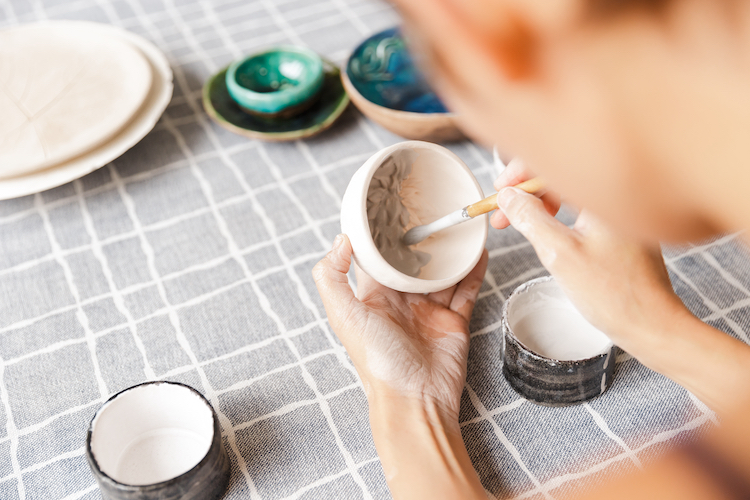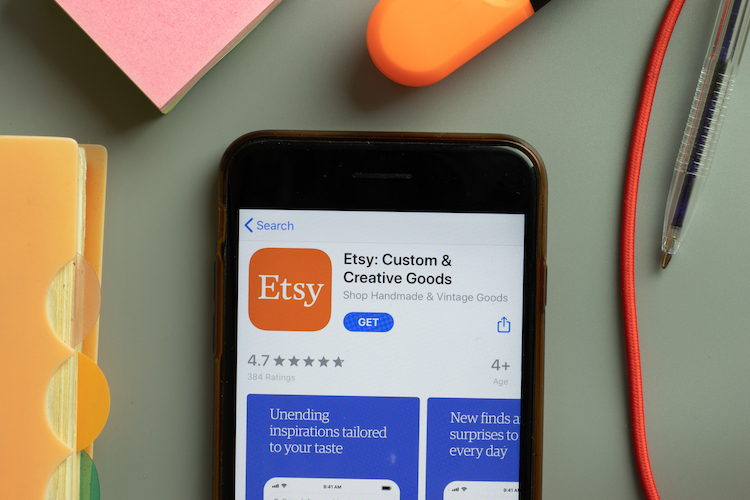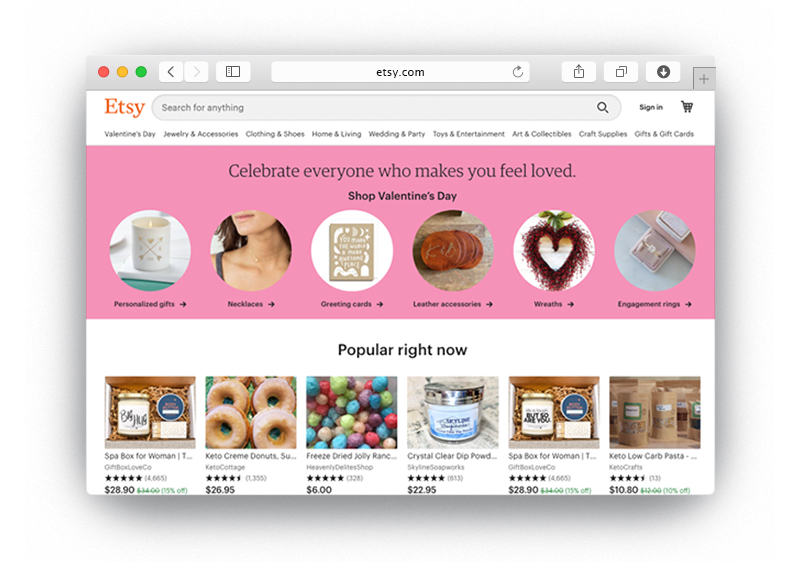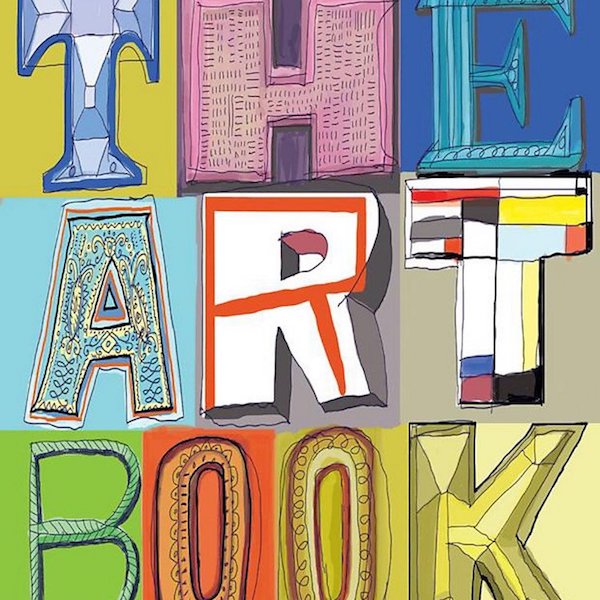
Photo: Stock Photos from Dean Drobot/Shutterstock
This post may contain affiliate links. If you make a purchase, My Modern Met may earn an affiliate commission. Please read our disclosure for more info.
Do you have a handmade product that you want to introduce to the world? One of the best places to do that is on Etsy. The massive online marketplace is continually showcasing the latest and greatest handmade items from makers around the world. From stylish home goods to things for your pet, there is likely a place for you on the site.
Etsy was founded in 2005 and by 2007, had its one-millionth sale. The popularity of the site has only continued to grow, and landing a spot on the home page or as an editor’s pick can bring a rush of new customers to your shop.
Wondering how to get started on Etsy and make your time selling there a success? Read on to learn more about building your Etsy shop as well as six of our top tips to know when opening your virtual doors.
Why Choose Etsy?

Photo: Stock Photos from Postmodern Studio/Shutterstock
One of the biggest reasons to choose Etsy is because of its popularity among vast groups of people. It has become synonymous with one-of-a-kind and handmade—a benefit for buyers and sellers. And best of all, people visit the site because they’re looking to buy something. They are primed and ready to purchase. All they need to do is to find (and fall in love with) your store.
Logistically, starting an Etsy shop is easy. You don't need to know any coding or have any specialized knowledge of e-commerce platforms to set up a successful store. You'll sign up on the site and there will be instructions on what you'll need to do to create your first listing, set up banking, fill out the about section, and more.
Getting to Know Etsy

How much does Etsy cost?
It costs nothing to open an Etsy store. And unlike other e-commerce platforms, there’s no monthly fee. Instead, you’ll pay .20 cents for each listing and once an item sells, Etsy will automatically deduct 5% of the sale price from your earnings.
This makes it a relatively low risk to open an Etsy shop. If you list five things and none of them sell, you’ve only spent $1 in fees. Consider this when comparing other platforms, which may charge a monthly fee no matter if you sell anything or not.
How will buyers find my stuff?
The marketplace continually refines how items are organized on its site and has become granular with its categories. When you’re listing your items, you’ll want to get as specific as possible to ensure that people browsing your chosen category (or categories) can easily find you. To do that, you’ll want to make sure that you determine keywords for your product. This will help ensure that you are placed in the correct group.
In addition to robust categories, Etsy allows registered users to favorite individual shops and individual items. They can also add them to curated lists that are, by default, public. These lists are another way for people to organically find you. And finally, Etsy editors are always looking and curating lists for various gifts.
How much can I customize my Etsy shop?
Like other online marketplaces, each shop will look about the same (with the exception of the photography and products you supply). So in terms of customization—such as colors and layout—there are limitations. That’s why your photography, titles, and item descriptions are so important. They let you differentiate yourself from others on Etsy.
Top Tips for Succeeding on Etsy

Photo: Stock Photos from rblfmr/Shutterstock
1. Carefully consider your titles.
Titles, along with your photographs, are the first thing that potential customers will see when they are looking at your shop or discovering your products via search. Use search engine optimization (SEO) research to determine relevant keywords that describe your products but are also something that people would search for, too.
For example: if you create embroidery kits, you’ll want to include the keywords “embroidery kit” and “DIY kit” in your title since those are topics people search for and they are an accurate depiction of your product.
2. Take advantage of new Etsy features.
Etsy periodically rolls out new features in order to keep up with overall internet trends. In 2020, for instance, it introduced the ability to place videos in your listing.
There are a couple of reasons to take advantage of new features. For one, there’s a good chance it will help you communicate more about your product to a potential customer—always a great thing. But the other perk to trying a new feature (even if it is in beta mode) is that Etsy might “boost” those listings that are testing the new feature and make them appear better in search (or more).
3. Snap great photos to stand out.
Because buyers see your product in person before they purchase, you’ll want to give them as much visual information about it as possible. That’s why it’s imperative that you take the best photos possible of your handiwork. Show the product in natural light and from multiple viewpoints (if necessary) and also show it in use; let customers imagine it in their lives by placing it in an environment. Or if you make wearables, show someone modeling your items.
One way to see how to style your photos is to look at what’s on the front page of Etsy or in the editor’s picks. Are the photos brightly lit? Colorful? How can you be inspired by these attributes for your own images?

Photo: Stock Photos from Kaspars Grinvalds/Shutterstock
4. Be detailed in your item descriptions.
Along with titles and photos, item descriptions are one of the most important parts of your listing. They give you the opportunity to explain your design process, materials used, dimensions of the item, and basically persuade people, telling them why they should buy your product. Use this space to write why someone needs your work in their lives. Maybe that’s by sharing the story behind it or pointing out how it makes a great gift.
5. Deliver great customer service.
This should go without saying, but delivering optimal customer service will help you in more ways than one. Hopefully, it’ll get you a great review after your item is delivered and a loyal customer that will buy from you again.
So, how do you do this? Make a buyer feel special. Be responsive if they have any questions about your product; the “messages” function of Etsy is your friend. Also, go the extra mile with your packaging. A nice handwritten note tucked in with your product is always welcome, and you can take it to the next level with thoughtful touches like gift wrap as well as freebies like stickers.
6. Be observant of like-minded shops and trends.
To be clear, you never want to copy what someone is doing. Not only is it unethical, but it’s also just not a creatively fulfilling thing to do. But, do be observant about what shops like yours are doing. How are they snapping photos? What kind of keywords are they using for people to find their products? This can give you inspiration for your own shop.
Another thing to look out for is trends. Etsy releases trend reports over the year and they’re always worth going over. They include things that Etsy sees as “up-and-coming” in categories including art, fashion, home, and more. If you can market your products to one of those trends—or even create a product that is part of it—there’s a chance that Etsy will place it in its “trending categories” that often appear as editors picks or on the front page.
Want more Etsy tips? Learn seven secrets of Etsy success from thriving shop owners.
It never hurts to take a course about Etsy to learn about this robust marketplace. The Etsy Training Course from Merriweather Council is a beloved e-course that shows you how to make the most of Etsy. The course content is updated as Etsy makes changes, and you have access to it all forever.
Related Articles:
Are You an Artist Looking to Sell on Shopify? Here’s How to Get Started
17 Ways for Artists to Sell Their Creative Work Online
7 Tips to Help Make Your Next Creative Project Go Viral
8 of the Most Popular Trade Shows to Get Your Art in Front of Thousands of Buyers
6 Professional Networking Tips to Further Your Creative Career




















































































